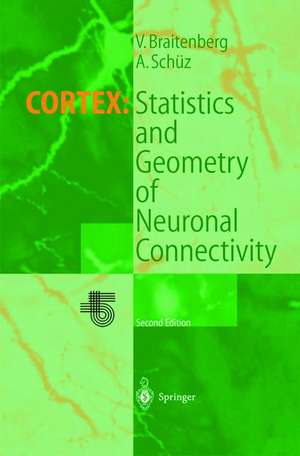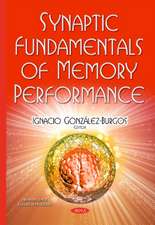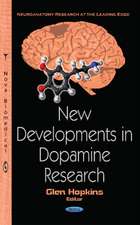Cortex: Statistics and Geometry of Neuronal Connectivity
Autor Valentino Braitenberg, Almut Schüzen Limba Engleză Paperback – noi 2012
Preț: 828.95 lei
Preț vechi: 1010.92 lei
-18% Nou
Puncte Express: 1243
Preț estimativ în valută:
158.62€ • 169.62$ • 132.25£
158.62€ • 169.62$ • 132.25£
Carte tipărită la comandă
Livrare economică 18 aprilie-02 mai
Preluare comenzi: 021 569.72.76
Specificații
ISBN-13: 9783662037355
ISBN-10: 3662037351
Pagini: 249
Ilustrații: XIII, 249 p.
Dimensiuni: 155 x 235 x 20 mm
Greutate: 0.38 kg
Ediția:2nd ed. 1998
Editura: Springer Berlin, Heidelberg
Colecția Springer
Locul publicării:Berlin, Heidelberg, Germany
ISBN-10: 3662037351
Pagini: 249
Ilustrații: XIII, 249 p.
Dimensiuni: 155 x 235 x 20 mm
Greutate: 0.38 kg
Ediția:2nd ed. 1998
Editura: Springer Berlin, Heidelberg
Colecția Springer
Locul publicării:Berlin, Heidelberg, Germany
Public țintă
ResearchCuprins
1 Introduction.- 2 Where is the Cortex?.- 3 Analysis of the Neuropil: Preliminary Remarks.- 4 Density of Neurons.- 5 Density of Synapses.- 6 Comparison Between Synaptic and Neuronal Density.- 7 Density of Axons.- 8 Comparison Between the Densities of Neurons, Synapses and Axons.- 9 Microscopic Evidence of the Spacing of Synapses on Axons.- 10 Statistics of the Synapses Along the Axons.- 11 Density of Dendrites.- 12 Different Kinds of Synapses.- 13 Interim Discussion.- 14 Morphology of Neurons: Golgi Pictures.- 15 Classification of Cortical Neurons.- 16 Quantitative Aspects of the Three Types of Neurons. Methods.- 17 Length of the Axonal Ramification of Individual Neurons.- 18 Length of the Dendritic Trees.- 19 Relative Density of Axons and Dendrites.- 20 The Likelihood of a Synapse Between Two Pyramidal Cells.- 21 Peters’ Rule and White’s Exceptions.- 22 Dendritic Spines.- 23 Synapses on Spineless Dendrites.- 24 In Search of Engrams.- 25 Postnatal Changes, Possibly Due to Learning, in the Guinea Pig Cortex.- 26 Cortico-Cortical Connections.- 27 Cortical Architectonics.- 28 Layers.- 29 Cyto- and Myeloarchitectonics: Two Aspects of the Same Reality.- 30 Special Areas.- 31 Map of the Cortex.- 32 How Cortex-Like Is the Hippocampus?.- 33 Summary of Statistical Anatomy and Conclusions Thereof.- 34 Comparative Aspects: Statistical Measures in Larger Brains.- 35 Global Activity, Cell Assemblies and Synfire Chains.- 36 Feature Detectors and Orientation Columns.- 37 Human Language: The Ultimate Challenge for a Theory of the Cortex. An Essay.- References.
Recenzii
From the reviews of the first edition:
"Textbooks of anatomy are usually extremely boring. Anatomy of the Cortex is fascinating!" Network (JOP)
"Braitenberg and Schüz have produced a masterpiece on the neurobiological foundations of cognitive psychology." Contemporary Psychology
"Textbooks of anatomy are usually extremely boring. Anatomy of the Cortex is fascinating!" Network (JOP)
"Braitenberg and Schüz have produced a masterpiece on the neurobiological foundations of cognitive psychology." Contemporary Psychology
Textul de pe ultima copertă
By means of quantitative analysis of the tissue components in the cortex of the mouse, this book presents an overall picture of the cortical network which is then related to various theories on cortical function. It is centered around the idea of a diffuse network in a fairly homogeneous population of excitatory neurons, that of the pyramidal cells. It shows that the whole organisation in the cortical skeleton of pryramidal cells correspondes well to the idea of an associative memory and to the theory of cell assemblies.The theoretical points are made on the basis of experimental results.
The reader not only obtains information about quantitative neuroanatomy, but also on the methods used, in particular those that vary from the norm.
The reader not only obtains information about quantitative neuroanatomy, but also on the methods used, in particular those that vary from the norm.
Caracteristici
The authors summarize and interprete over 20 years of anatomical research on the cerebral cortex Composed of 35 short chapters, each introducing its topic in a concise and highly lucid way Clear illustrations help grasp the intricacies Illuminates the issues that interest anatomists, physiologists and neural network theoreticians















